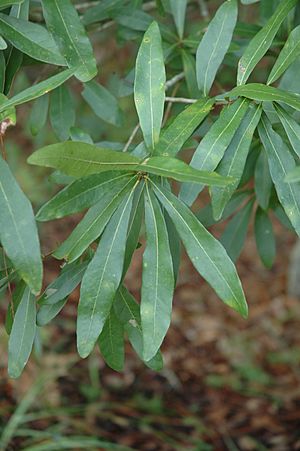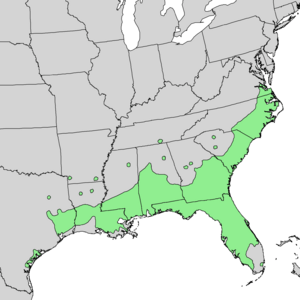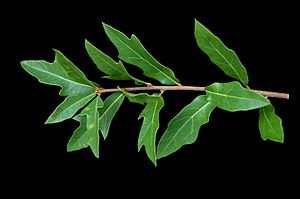Swamp laurel oak facts for kids
Quercus laurifolia is a special kind of oak tree known by many names, like swamp laurel oak, diamond-leaf oak, water oak, obtusa oak, and laurel oak. It's a medium-sized tree that keeps its leaves for most of the year, only losing them briefly in spring. This tree is part of the red oak family. You can find it growing naturally in the southeastern and south-central parts of the United States, from Virginia all the way down to Florida and west to Texas.
Quick facts for kids Swamp laurel oak |
|
|---|---|
 |
|
| Conservation status | |
| Scientific classification | |
| Genus: |
Quercus
|
| Species: |
laurifolia
|
 |
|
| Natural range of Quercus laurifolia | |
| Synonyms | |
|
List
Quercus aquatica var. laurifolia (Michx.) A. DC.
Quercus phellos var. laurifolia (Michx.) Chapm. Quercus uliginosa var. laurifolia (Michx.) Zabel Quercus laurifolia var. acuta Willd. Quercus laurifolia f. dentata Trel. Quercus laurifolia var. hybrida Michx. Quercus laurifolia f. obovatifolia (Sarg.) Trel. Quercus laurifolia var. obtusa Willd. Quercus laurifolia var. rhombica (Sarg.) Trel. Quercus laurifolia var. tridentata Sarg. Quercus obtusa (Willd.) Ashe Quercus obtusa Sarg. Quercus obtusa (Willd.) Pursh Quercus obtusa var. obovatifolia (Sarg.) Ashe Quercus rhombica Sarg. Quercus rhombica var. obovatifolia Sarg. |
|
Contents
What Does the Swamp Laurel Oak Look Like?
The swamp laurel oak usually grows to be about 65 to 80 feet (20 to 24 meters) tall. Sometimes, it can even reach an amazing 130 feet (40 meters)! It has a wide, round shape at the top, called a crown.
Its leaves are long and narrow, about 1 to 5 inches (2.5 to 13 cm) long. They are usually smooth on the edges, but very rarely, they might have three small bumps or lobes. These leaves stay on the tree almost all year. They only fall off right when new leaves start to grow in the spring.
The tree also produces acorns, which are its seeds. These acorns are small, about 0.35 to 0.5 inches (9 to 13 mm) long. They start green and turn a dark brownish-black color about 18 months after the tree is pollinated. Even though the inside of the acorn tastes bitter, many animals love to eat them. Deer, squirrels, and different kinds of birds all enjoy these acorns. The tree often makes a lot of acorns, which is great for wildlife.
How Swamp Laurel Oaks Grow
Swamp laurel oaks grow quite fast. They usually become fully grown in about 50 years. This fast growth makes them popular for planting in parks and yards. While they can get some insect visitors, they don't usually have serious bug problems. Some small beetles, called weevils, like to live in their acorns.
Some scientists once thought that the swamp laurel oak might be a mix of two other oak trees: the willow oak and the water oak. This idea came from studying the shape of leaves on young trees. However, most scientists today agree that the swamp laurel oak is its own unique species.
Where Swamp Laurel Oaks Live
Swamp laurel oaks mostly grow in areas where rivers have left behind rich soil, like floodplains. These are flat areas near rivers that can sometimes get wet. They can handle wet ground, but they don't like to be flooded all the time. You'll often find them in sandy soil close to rivers or on the edges of swamps. In Florida, they grow in special forest areas called hammocks, or on sand hills next to swamps. They grow best in certain types of soil called ultisols and inceptisols.
The places where these trees grow have average yearly temperatures between 61 to 70 degrees Fahrenheit (16 to 21 degrees Celsius). They can survive very cold temperatures, sometimes as low as 20 degrees Fahrenheit below zero (-28 degrees Celsius). They can also handle very hot temperatures, up to 100 to 109 degrees Fahrenheit (38 to 43 degrees Celsius).
These trees need a good amount of rain, usually between 49 to 59 inches (1250 to 1500 mm) each year. A lot of this rain, about 20 to 39 inches (500 to 1000 mm), falls during their growing season from April to September. The swamp laurel oak is one of the best evergreen oaks at handling cold weather. Trees in colder places have even been seen staying green into December, showing how tough they are.
Uses of the Swamp Laurel Oak
The wood from swamp laurel oaks is often used to make pulp, which is then used for paper and other products. Because they grow quickly and look nice, they are also widely planted as ornamental trees in landscaping. People plant them in many different types of soil.
The acorns from these trees are an important food source for many animals. Raccoons, white-tailed deer, wild turkeys, squirrels, ducks, bobwhite quail, and other small birds and rodents all rely on these acorns for food.
See also
 In Spanish: Quercus laurifolia para niños
In Spanish: Quercus laurifolia para niños



